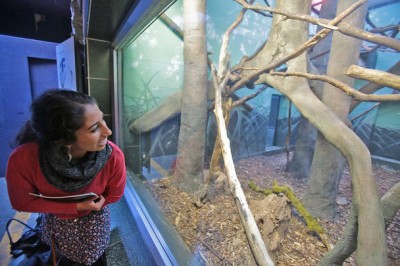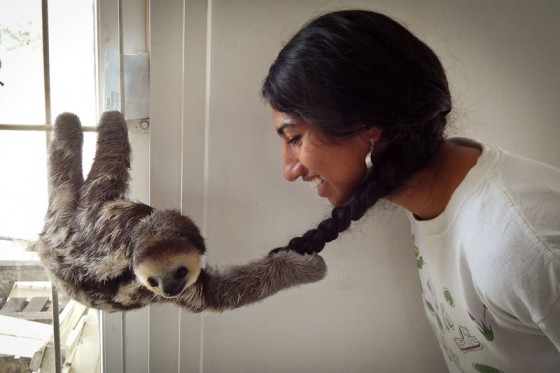Captivated by what she saw in an online video, a Lakeside School student travels to Suriname to learn more about protecting sloths and writes a book.
Sharanya Sarathy, of Seattle, wants to save the sloths of Suriname.
This may sound like a Dr. Seuss poem, but in fact it’s the real-world result of one teenager’s online love affair with a funny-looking animal.
“About two years ago, that’s when sloths started becoming popular on the Internet,” says Sarathy, referencing the rise of memes starring the grinning long-limbed creature. “They’re really bizarre and really cute at the same time.”
But where most people saw a funny way to waste time at work, Sarathy saw an opportunity.
Sarathy, 17, started researching sloths — their behavior, habitat and threats. Almost immediately she came across the work of Monique Pool, a woman in the South American country of Suriname who rescued hundreds of sloths displaced by bulldozers that razed their forest home to clear grazing land for cattle.
“I thought ‘That’s who I want to be!’ ” says Sarathy of watching an Internet video of Pool working out of her home, which has been converted into a sloth sanctuary. So Sarathy contacted Pool and asked if she could come help.
“She said, ‘Sure, if you can find your way to this country, then of course you can help me,’ ” says Sarathy, remembering the email with a smile.
So she started saving money from baby-sitting and a job at the Lakeside School in Seattle where she’s a senior, to help pay for a plane ticket. Last summer she traveled to Suriname to spend 20 days working alongside Pool, doing everything from weighing sloth babies to helping with research.
Sarathy is an animal lover who has volunteered at the Woodland Park Zoo for years. But she says there is something special about sloths, something that inspired her to pack up for the Amazon.
Sarathy can rattle off threats to the sloth — from deforestation and habitat loss to the pet trade — as easily as she can spout sloth trivia — they spend most of their lives upside down, can turn their heads 180 degrees and have such slow metabolisms they poop only once a week.
She admits the unique “cuteness” of the animals, which she describes as a “mix between Chewbacca and a koala,” is a draw. But she says what really inspires her is that sloths represent a conservationist’s cause that actually has a lot of hope.
“I think people can get almost depressed when they hear about the polar bear and the Arctic and climate change,” says Sarathy “But I think sloths provide an optimistic counter example. Yes, the sloth is threatened, but it’s not at that brink yet.”

With that goal in mind Sarathy has written a children’s book titled “Pool House Sloths,” which is available at Amazon.com.
It stars “Lucas,” a baby sloth living at Pool’s house in Suriname. The book is full of sloth factoids (did you know that sloths move so slowly that camouflaging algae grows on their backs?) All of the profits from book sales will be donated to Pool’s organization, the Green Heritage Fund Suriname.
Sarathy’s sloth obsession — complete with a sloth-themed license-plate frame — can seem comical. But get her near one of the animals and there is nothing but awe.
We met up at the Woodland Park Zoo on a brilliant afternoon full of fall colors against a clear blue sky. But we quickly left the sun in favor of a dim, low-ceilinged exhibit. At the far end, snuggled among sawed-off branches and a mural mimicking a leafy canopy, was a sleepy two-toed sloth.
Sarathy tells me it’s a different kind than the type she worked with in Suriname (those were of the pale-throated, three-toed variety), but her rapture is unaffected.
“Hi there,” she says touching the glass as the sloth stretches a furry blond neck toward her, its round shadowed eyes blinking slowly.
Just then a woman and toddler wander up to the glass, curious about what kind of animal Sarathy is talking to.
“Let’s go look at the meerkats — they move around,” says the woman immediately upon seeing the sloth’s head dangling lazily out of a wooden box.
“So funny looking.” she adds, brushing past.
Sarathy, who is tilting her head to get a better look, hardly notices.


